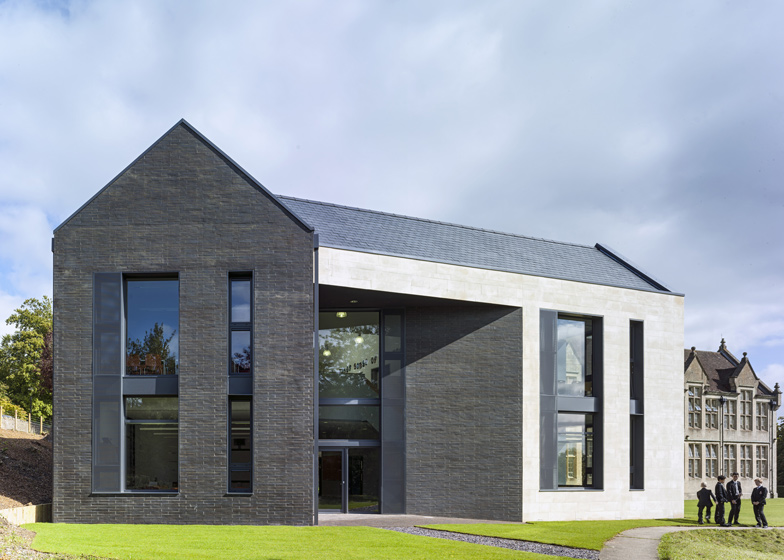This school building in Bath, England, by local architects Mitchell Taylor Workshop features stone walls recalling the city's historic architecture, alongside contrasting dark grey brickwork and window surrounds (+ slideshow).
The design by Mitchell Taylor Workshop was the winning entry in a competition for a humanities building at Kingswood School, to be built on the school's picturesque Lansdown Road grounds.
Located within a designated conservation area and World Heritage Site, the materials used for the facility's exterior had to meet strict planning regulations.
The use of stone references Bath's historic buildings and the architects chose to add contrast by introducing a grey brick that resembles slate, a material that is also part of the area's architectural heritage.
"The choice of materials evolved from the desire to create a playful front and back tectonic narrative," the architects explained. "After the planners had requested that stone be used, we then identified another heavily used material in Bath, slate, and argued that a long dark brick had the quality of a slate block, which they accepted."
One of the two-storey building's facades is angled towards an open grassy area and features gables clad in pale stone, contrasting with the tall grey windows that echo the front of the adjacent Ferens Building, built in 1924.
"The new design evolved to be a contemporary interpretation of both the Ferens Building and the local context of the world heritage site," said the architects. "The form and proportion of the roof structure and openings is a response to the rhythm of the Ferens building's facade, with the tall windows and perforated panels."
Grey brick was used to clad the rear portion of the classroom facility, including a large gable end that combines with an angled wall to frame a tall glazed entrance.
An overhanging canopy on the opposite side of the building covers the main entrance, which leads to a central circulation area used as a conference, exhibition and social space.
Eight classrooms and three staff rooms are housed over two storeys in a pair of blocks arranged on either side of the circulation and display area.
The grey window frames that project from the southern facade provide solar shading and incorporate perforated panels covering windows that can be opened to provide ventilation in any weather.
Pupils in the upper-floor classrooms can look out across the lawn towards the surrounding countryside.
Photography is by Peter Cook.
Here's a project description from the architects:
Kingswood School, Bath, England
Mitchell Taylor Workshop were invited by Kingswood School to submit a proposal for a limited competition for the design a new humanities building in May 2012. The site is located on the school's Lansdown Road grounds in Bath within both the Conservation Area and with a World Heritage designation. The winning scheme was to house eight new classrooms and three departmental resource areas and a flexible circulation space that could be used for exhibiting work and for external academic and conference functions.
The form and orientation of the building was generated from site constraints in maximising the natural daylight and ventilation into the classroom spaces whilst controlling solar gain. The building is aligned along Fonthill Road to the north-east and is effectively divided into two blocks with the southern elevation orientated to the immediate open space and the extraordinary views beyond. The internal spaces unfold from a large overhang which provides a covered canopy and connects to an internal triangular plan shaped circulation area which allows for the pupils to display and exhibit their work and as breakout and social space.
Adjacent to the new classroom site is the existing Ferens Building, built in 1924. The new design evolved to be a contemporary interpretation of both the Ferens Building and the language of the heritage buildings of Bath with defined fronts and backs. The form and proportion of the roof structure and openings is a response to the rhythm of Ferens building facade with the tall windows and perforate panels.
The choice of materials evolved from the desire to create a playful front and back tectonic narrative. After the planners had requested that stone be used, we then identified another heavily used material in Bath, slate, and argued that a long dark brick had the quality of a slate block which they accepted. The proposal evolved to incorporate the stone on the south with the dark brick on the north façade creating a unique architectural composition.
Our experience of working with independent schools has brought about an expertise in a variety of building types from libraries, to boarding houses, theatres to classrooms, sports halls to energy centres. The Independent Schools have a strong identity and aspire to reflect this within the built environment. Budgets and time constraints are also well defined but this should not restrict the aspiration to produce interesting and relevant architectural buildings and places.
Mitchell Taylor workshop developed their proposal working very closely with the staff and pupils of the school. The school wanted to occupy their new building at the start of the 2013/14 academic year which meant a design and construction period of little over 12 months. The budget resulted in a construction value of £1,700/sq.m which meant that both the design and construction needed to well considered, co-ordinated and efficient as well as making a positive contribution to the built and academic aspirations of the school.
Gross Internal Floor Area - 632m²
Form of Contract or Procurement Route– JCD ICD 2011
Cconstruction Cost Per m2 - £1640/m2
Architect – Mitchell Taylor Workshop
Client – Kingswood School
Structural Engineer – Mann Williams
M&E Consultant - King Shaw Associates Ltd
QS – Bishopston Stephens
Project Manager – Bishopston Stephens
CDM Coordinator - Anderson FM Consulting Ltd
Approved Building Inspector – Bath & North East Somerset Council
Main Contractor - Beard








